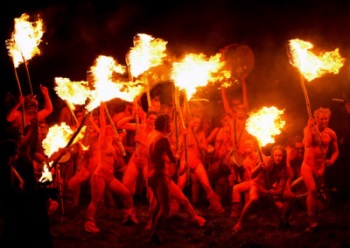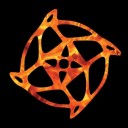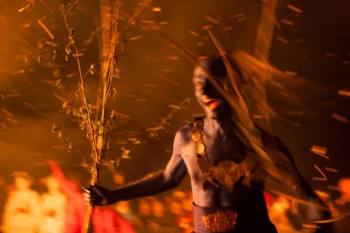The Celtic Festival of Beltane - Fire and Fertility
Originally Posted to Transceltic on April 16, 2014, by Emmett McIntyre
The Celtic year is divided by the four annual Celtic Feast Days which are celebrated on the first of the month: the November Celtic New Year of Samhain (Halloween), Imbolg which was also the Feast Day of the Celtic Goddess Brigid in February, the May Spring Festival of Beltane and the August Harvest Festival of Lughnasa.
Unique amongst the Four Celtic Feast days, Beltane observances have survived in essentially archaic form due in part to its simplicity in that the celebrations historically included the lighting of bonfires. Elements of the tradition have survived into modern times throughout the Six Nations with remnants of the ancient customs surviving into the 20th century in Ireland, Cornwall, Scotland and the Isle of Man (MacKillop). As the Pan-Celtic movement continues to strengthen, Beltane is experiencing resurgence.
There is evidence that Beltane had its origins in rituals associated with the Pan-Celtic Solar God "Bel" and it is believed that the Druidical Orders historically played a central role." This was a time when the Celts offered praise to Bel, who was not only a god of death but of life as well, for he is represented as a solar deity and he was regarded as having gained victory over the powers of darkness by bringing the people within sight of another harvest. On that day (Beltane) the fires of the household would be extinguished. At a given time the Druids would rekindle the fires from the torches lit by 'The Sacred Fires of Bel', the rays of the sun, and the new flames symbolized a fresh start for everyone.(Ellis)
The sources agree that Beltane was universally celebrated throughout the Celtic world and was centered on the fertility of the new season: " The festival was associated with the start of open pasturing, with the beginning of summer and the welcoming of the sun’s heat…Bonfires were kindled in sympathetic magic…two fires were lit by Druids and animals were driven between them in a magical fertility rite.(Green)
The themes of fire and fertility run deep in the historic record and into modern times which is reflected in the sexual connotations connected to Beltane: " Beltane Dew was believed to have the power to increase sexual attractiveness. Maidens would roll in the grass or dip their fingers in the dew...one of their numbers would be chosen as the May Queen. Sexual license, with the magical intentions of increasing the land’s yield, is believed to have been part of the annual event.” Beltane customs continued in parts of England as Celtic folk memories centred on the May Pole, “...a transparently phallic symbol..."(Monaghan)

An example of the modern day observance of Beltane is the popular Edinburgh "Beltane Fire Festival", an elaborate stylized interpretation of ancient Beltane traditions and ritual based on historic Celtic practices. The survival of Celtic religious practices is startling. For example, the Blue Men are described on the Edinburgh festival’s web page as keepers of “Beltane Lore”, which is generally speaking, the role of the Druid in Celtic society as the Druidical tradition banned the writing down of knowledge and ritual practices. The festival culminates in the lighting of bonfires which is the central theme of the historical accounts of the ancient Celtic rites.
The noted scholar and Scottish Folklorist Margaret Bennett, who was a participant in the 1988 revival of the Edinburgh Beltane Festival, cites the Druidical links to Beltane and comments on the traditions being created at the Edinburgh Festival: " At dawn everyone arose to welcome the sun and to wash in the May dew, thought to have been the holy water of the Druids, but, according to oral tradition, believed to assure beauty. The widespread May dew custom outlasted the Beltane fire which died out in the 19th century, though 1988 saw the revival of it in Edinburgh. Since then, the Beltane Fire Festival is held annually on Calton Hill, and combines tradition with theatre. It is presided over by the May Queen, a Green Man, several Red and Blue Men, many drummers and dancing maidens.
Four thousand miles from Edinburgh, the Beltane tradition also survives in New Franklin, Ohio. The local Scottish American Society holds the annual Beltane Festival, essentially a Celtic cultural celebration. The spokesman for the Ohio event, Dr. James Frost, gave us the following: " We invite folks with Scottish, Irish, Welsh, Manx heritage (primarily) to attend a day of festivities: heavy athletics as performed at most Scottish games, piping and a full pipe band, fiddlers, harpers, Welsh country dancing, Scottish country dancing, singing, Irish step dancing and a Beltane bonfire."
Interview with Festival "Scribe" Tanya
Transceltic contacted the Beltane Fire Festival organizers in 2013 and posed the following questions to Tanya, the designated Festival "Scribe":

1. Do you consider the festival to be a continuation of the historical Celtic Feast day or is it something new or different?
Beltane Fire Festival is, and always has been, inspired by Celtic traditions. Beltane Fire Society is a registered charity and part of our charitable aims involves the celebration and sharing of these traditions. Our festival includes traditional characters, like the May Queen and Green Man, and performances are often inspired by recognisable archetypes from Celtic stories, for example our Samhuinn Fire Festival includes the Cailleach, the divine hag from Scottish and Irish mythology, but we also embrace modern retellings and interpretations of myth and legend. Like with historical Beltane traditions, we celebrate the onset of summer and the turning of the wheel of the year into the new season ahead.
2. Do you view the Festival as a Cultural or Religious event?

Beltane Fire Society is a secular organisation, so we have no religious ties whatsoever. We have a number of Pagan members who are drawn to our Society because we celebrate events which resonate with their own festivals, but we also have a lot of members who get involved because they enjoy taking part in public theatre - people with backgrounds in acrobatics, dance, music and fire performance, for example - and plenty who simply love being part of a diverse, creative community and sharing something fun and exciting with their friends. We have participants and audience members from all over the world and Beltane has definitely become part of Edinburgh's festival culture and a great reason to visit Scotland!
3. What do you see as the future of the festival?
As Beltane Fire Festival is a volunteer-run community event, the nature of the festival is a very much self-determining phenomenon and the event is in a constant state of evolution, with different people sharing their creativity and vision every year, shaping the performances. We welcome fresh perspectives and changing interpretations of the Celtic traditions that inspire the festival, so it’s always very exciting to create a new event each year! There are characters who appear year after year - like the May Queen and Green Man, Blue Men, White Women and Red Men (although some years the Blues, Whites and Reds don't identify with any particular gender) - and fire is always a big part of the event! It's very difficult to predict the future of Beltane because it’s so dependent on the individuals who take part each year.
Transceltic urges our readers to support the Festival. Based on the ancient Celtic Feast Day, the Edinburgh's Beltane Fire Festival is developing its own traditions. Consistent or not with the ancient practices of the Druids, the great Celtic Feast day heralding the beginning of the agricultural year is renewed and the spirit of the past lives on. Transceltic applauds and supports the Edinburgh Fire Festival as a vital source in the preservation, protection and promotion of Celtic culture.
Beltane Fire Festival 2014 will be held on Calton Hill, Edinburgh, Scotland, on Wednesdat 30th April. Entrance by Waterloo Place. Gates open at 8pm. Show starts at 9.30pm For more information visit the Beltane Fire Society website.
Sources
- Peter Beresford Ellis; "Dictionary of Celtic Mythology"
- Miranda J. Green; "Dictionary of Celtic Myth & Legend"
- Patricia Monaghan; "The Encyclopedia of Celtic Mythology and Folklore"
- Margaret Bennett – Handing on Tradition (external website)

- Emmett McIntyre's blog
- Log in to post comments






